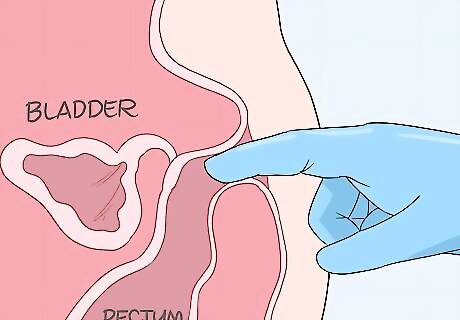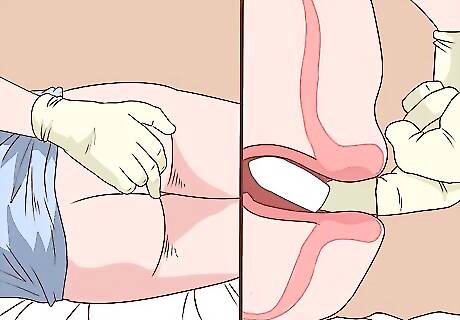
views
X
Research source
These exams should be done fairly regularly (yearly or so) as part of your health physical. Trained medical professionals are the only people who should give rectal exams since untrained individuals can injure the delicate rectal/anal tissues while probing.
Giving a Rectal Exam

Explain the procedure and make sure consent is provided. If you are a medical professional who will be performing an anorectal exam, then your first step should be to explain to your patient what the exam entails. Then, have the patient sign a consent form if they agree to undergo the procedure. You could explain the procedure by saying something like, “For this exam, I will be inserting a gloved finger into your rectum to check for abnormalities. You may experience some pressure and/or discomfort, but the exam only takes a minute or two.”

Sanitize your hands and wear gloves. Before performing any type of physical exam on a patient/person, it's important to wash and sanitize your hands because you don't want to transfer any bacteria, viruses, or parasites to them. Using warm water with soap is usually adequate, but you may want to use an alcohol-based sanitizing gel also. Dry your hands thoroughly and then put on a new pair of nitrile or latex-free examination gloves. In the medical field, digital rectal exams (DRE) are typically done by your family doctor, gynecologist, proctologist, or nurse practitioner. Proctology is the branch of medicine that deals with problems of the anus, rectum and colon.

Reassure the patient/person and tell them to lay on their side. Giving and receiving a digital rectal exam can be awkward or embarrassing for people, so acting professionally and reassuring the patient/person is important. After explaining the procedure in general, ask the patient/person to remove their bottoms, lay off their side (typically left side down), bend their knees, and place their hands near their chest — this is essentially the fetal position or on their left side with their knees flexed. Keep them covered with a gown or blanket for privacy and warmth. Place a protective pad under their buttocks as well. DRE can be done with the patient/person standing. Women may be examined as part of the pelvic exam therefore they may be laying back with their feet in stirrups. Men are often examined while they are standing up unless they are feeling nervous and then laying down may be more comfortable. Laying on their side is often more relaxing and provides better access to the anal canal. To feel more comfortable, it may be best to have a DRE carried out by someone of the same gender. Man on man or woman on woman, a request for a nurse to be present is also an option. It may also help ease anxiety and vulnerability to have a friend or family member present during the exam. Position and drape the patient for warmth as well as privacy.

Apply warm lubricant to your index finger. As a courtesy and to prevent the patient/person from being too shocked and uncomfortable, make sure the lubricant is warmed up a little before applying some to your index finger. Even room-temperature gel can feel cool and cause the anal canal to contract, which makes the digital exam more challenging. The goal is to have the anal tissue as relaxed as possible, so inserting a finger doesn't become uncomfortable or painful. Sometimes a rectal examination is carried out using a local anesthetic in order to numb the anal area and reduce discomfort. This is particularly true if the examiner has large fingers and the examinee has an especially tight anal sphincter. Electric gel warmers are inexpensive and can be purchased at medical supply stores. Alternatively, most gels and lubricants can be warmed in a microwave for 20-30 seconds.

Insert your finger into the anal canal gently. Once your finger and the anus are lubricated with warm gel, part the patient's / person's buttocks and slowly insert your index finger. It's best to ask the patient/person to take a deep breath during the insertion of the finger in order to relax them and prevent them from contracting their anal sphincter. To facilitate the insertion of the finger, slowly rotate or twist your hand at your wrist in a back and forth motion. Right before inserting your finger, quickly assess the anus for any abnormalities, such as hemorrhoids (swollen blood vessels), warts, rashes or fissures (tissue tears). After your finger is fully the rectum, assess the anal tone (strength) by asking the patient / person to bear down and try to squeeze your finger.

Feel for any abnormalities. Once inside the rectum, use your index finger to feel for any abnormalities, such as unusual bumps, hard spots, soft spots or fissures. Rotate your finger clockwise then counterclockwise to feel the entire internal circumference of the rectum. If the patient is a male, palpate the prostate gland through the wall of the rectum. Feel anteriorly (towards the front) for the prostate, which has two lobes with a cleft between them. A healthy prostate gland is smooth to the touch and not painful upon probing. If pressing on the prostate gland hurts, it may be a sign of benign growth, infection, or cancer. It's normal to feel like urinating when the prostate gland is pressed / probed from the anal canal.

Remove your finger and clean the area when finished. Once you're finished with your assessment, slowly remove your index finger and examine the glove for the presence of any blood and/or mucus. Then clean off any lubricant around the anus and remove and dispose of your gloves, and wash your hands. Allow the patient to wipe themselves off in privacy with some soft tissue paper and let them know they can get dressed. To remove your soiled glove, take your index finger of your other hand (which should be clean), place it under the cuff of the soiled glove, then pull down towards your fingers and peel it off. The exam itself shouldn't cause bleeding, so if you see blood on your glove that could be a signs of hemorrhoids or another internal problems. After the procedure, check to see how the patient is feeling, especially if he was nervous before the procedure began. Also, keep in mind that going from a laying to standing position can make some people feel faint, so encourage the patient to do this slowly and observe them for a few minutes.
Understanding Rectal Exams

Get an anorectal exam if you have blood in your stool. If you notice blood in the toilet when you defecate (poop) or while you're wiping yourself afterwards, then schedule an appointment with your doctor. If your doctor suspects you are bleeding from somewhere in your digestive tract (large intestine or colon, particularly), then they may want to perform a colonoscopy. Common reasons to see blood include hemorrhoids, small anal fissures and broken blood vessels from straining or wiping too hard. More serious, but unusual causes for blood include: anorectal cancer or some form of irritable bowel syndrome, such as ulcerative colitis or Crohn's disease. A normal finding means your doctor didn't find anything obvious, but an anorectal exam does not rule out all problems. Other tests, including a colonoscopy or x-ray, might be needed. A DRE is typically performed without using any drugs or anesthesia because it's seldom painful. The exam only takes a few minutes to complete.

Get an exam if you're a man and have trouble urinating. Another common reason to get an anorectal exam is to check the male prostate gland for abnormal growth or tenderness. The prostate is a walnut-sized gland that secretes fluid during ejaculation that protects and nourishes sperm cells. The prostate is located near the bladder and in front of the rectum, which makes it easy to check during a DRE. An enlarged or inflamed prostate causes internal pelvic pain and problems with urination, such as dribbling and trouble initiating. In men, a DRE is done to check the size of the prostate gland and to look for abnormal bumps or tenderness. Slow benign prostate growth is very common (but not serious) in America men older than 50 years. However, a malignancy is serious and further tests and early detection increase the chances of recovery. Go for yearly checkups or more often if you think there might be a problem. If your doctor thinks your prostate feels abnormal, they will likely order a blood test and look for your prostate-specific antigen (PSA) levels. High PSA levels sometimes indicate prostate cancer. Another test to help diagnose a prostate problem is a prostate ultrasound (transrectal ultrasound), which is often done in conjunction with a glandular biopsy (tissue sample).

Incorporate an anorectal exam into your yearly physical. Most doctors recommend adding a DRE to your routine yearly physical exam once you turn 45, regardless if you're male or female. Men should consider a DRE with a proctologist as part of an annual prostate screening exam. Women should get these tests done in conjunction with their annual gynecological exams. If you have a family history of colorectal cancer, talk to your doctor about whether you need to be screened earlier. For men, a DRE is often done standing and bent over at the waist as it's easier to access the prostate gland. Uterine and ovarian cancer can also be tested for in women when a DRE is done along with a vaginal exam. In addition to rectal bleeding and urinary issues, other reasons for getting a DRE include: a change in bowel habits, pelvic and/or abdominal pain, and discharge or bleeding from your urethra.
















Comments
0 comment